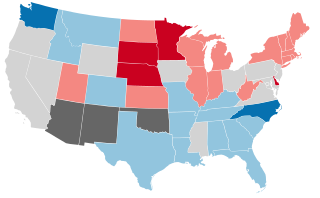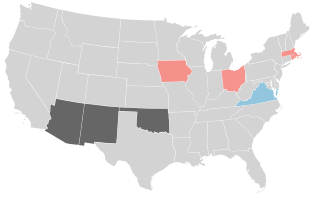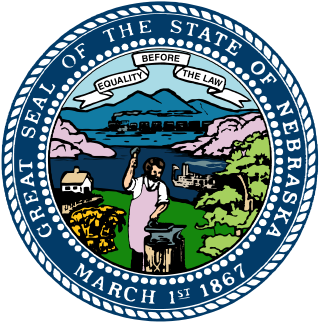
Daniel Lindsay Russell Jr. was an American politician who served as the 49th governor of North Carolina, from 1897 to 1901. An attorney and judge, he had also been elected as state representative and to the United States Congress, serving from 1879 to 1881. Although he fought with the Confederacy during the Civil War, Russell and his father were both Unionists. After the war, Russell joined the Republican Party in North Carolina, which was an unusual affiliation for one of the planter class. In the postwar period he served as a state judge, as well as in the state and national legislatures.

The 1898 South Dakota gubernatorial election was held on November 8, 1898. Incumbent governor Andrew E. Lee, elected in 1896 as a Populist, he ran for re-election as a Fusion candidate. He was challenged by Republican nominee Kirk G. Phillips, the state treasurer. Lee narrowly defeated Phillips to win his second term as governor, but most of his Fusion allies lost their elections, leaving him as the lone statewide officeholder.

The 1900 South Dakota gubernatorial election was held on November 6, 1900. Incumbent Governor Andrew E. Lee, a Populist elected under Fusion with Populists, Free Silver Republicans, and Democrats, opted to run for Congress rather than for a third term. Former Sioux Falls Mayor Burre H. Lien won the Fusion nomination and ran against former Lieutenant Governor Charles N. Herreid. However, despite the closeness of the 1896 and 1898 elections, the Fusion's luck ran out; Herreid defeated Lien in a landslide to reclaim the office for the Republican Party.

The 1894 Wyoming gubernatorial election was held on November 6, 1894. Democratic Governor John E. Osborne, first elected in the 1892 special election, declined to seek re-election to a second term, instead aiming to be elected to the U.S. Senate. In part because of a backlash against the Democratic Party owing to the Panic of 1893, Republicans won the governorship back from the Democrats, and would hold onto it until 1914.

United States gubernatorial elections were held in 1906, in 28 states, concurrent with the House and Senate elections, on November 6, 1906.

United States gubernatorial elections were held in 1902, in 27 states, concurrent with the House and Senate elections, on November 4, 1902.

The 1896 Michigan gubernatorial election was held on November 3, 1896. Republican nominee Hazen S. Pingree defeated Fusion candidate of the Democratic, People's, and Union Silver parties, Charles R. Sligh with 55.57% of the vote.

The 1898 Michigan gubernatorial election was held on November 1, 1898. Incumbent Republican Hazen S. Pingree defeated Fusion candidate of the Democratic, People's, and Union Silver parties, Justin R. Whiting, with 57.75% of the vote.

United States gubernatorial elections were held in 1900, in 34 states, concurrent with the House, Senate elections and presidential election, on November 6, 1900.

United States gubernatorial elections were held in 1899, in seven states.

United States gubernatorial elections were held in 1897, in five states.

United States gubernatorial elections were held in 1896, in 32 states, concurrent with the House, Senate elections and presidential election, on November 3, 1896.

United States gubernatorial elections were held in 1894, in 28 states, concurrent with the House and Senate elections, on November 6, 1894.

The 1900 North Dakota gubernatorial election was held on November 6, 1900. Republican nominee Frank White defeated Democratic nominee Max Wipperman with 59.20% of the vote.

United States gubernatorial elections were held in 1892, in 32 states, concurrent with the House, Senate elections and presidential election, on November 8, 1892.

United States gubernatorial elections were held in 1888, in 26 states, concurrent with the House, Senate elections and presidential election, on November 6, 1888.

The 1900 Nebraska gubernatorial election was held on November 6, 1900.

The 1898 Nebraska gubernatorial election was held on November 8, 1898. Incumbent Populist Governor Silas A. Holcomb did not stand for re-election. Populist and Democratic fusion nominee William A. Poynter defeated Republican nominee Monroe Hayward with 50.19% of the vote.

William Anderson Guthrie was an American lawyer and politician. Born in Chatham County, North Carolina, he attended the University of North Carolina at Chapel Hill and served in the Confederate States Army during the American Civil War. After the war, Guthrie married and moved to Fayetteville to practice law. He located his practice to Durham in 1884.

The 1898 Nebraska lieutenant gubernatorial election was held on November 8, 1898, and featured Populist and Democratic fusion nominee Edward A. Gilbert defeating Republican nominee George A. Murphy as well as Prohibition nominee Newell S. Lowrie and Socialist Labor nominee J. J. Kerrigan.



















